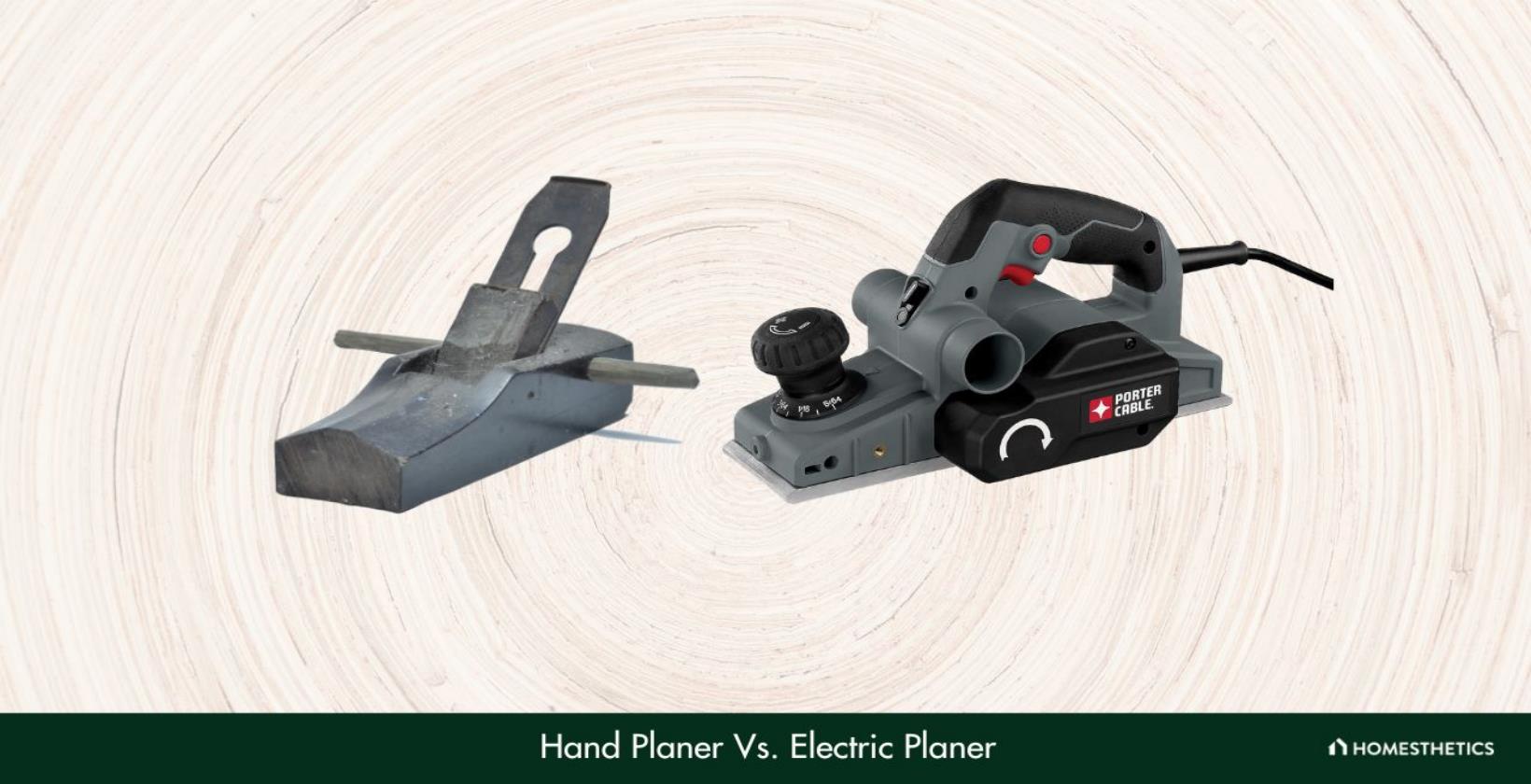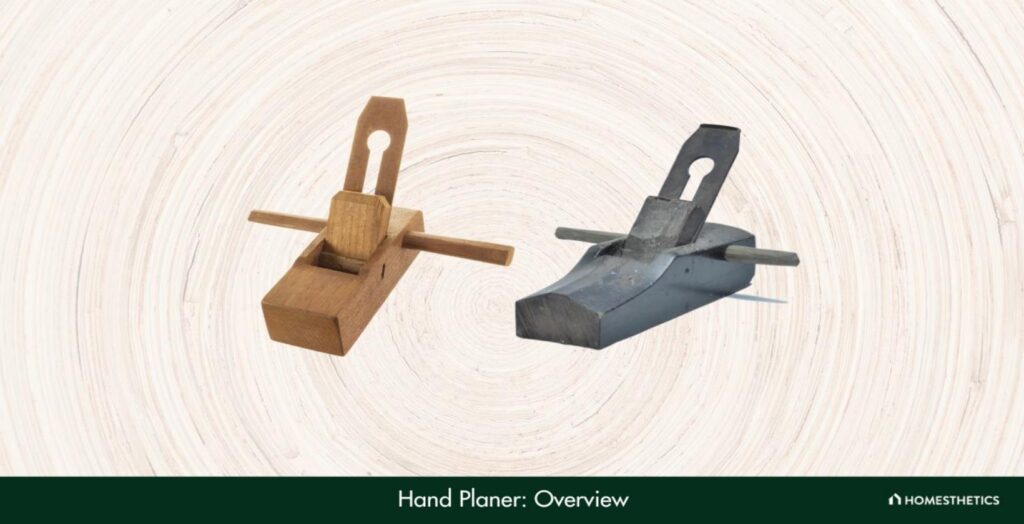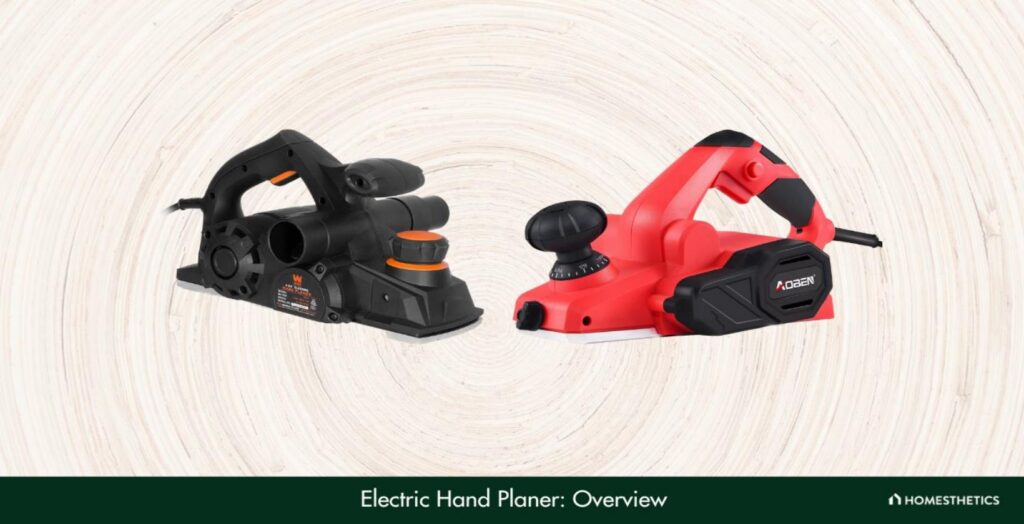For carpentry projects with high precision, hand planers would be the right choice, as they are a handy tool for trimming swollen edges and making radius cuts on lumbar pieces. Conversely, electric planers are ideal for working on large surfaces.

Hand planers and electric planers are essential woodworking tools for woodworkers and carpenters everywhere.
With planers, almost all woodworkers struggle to choose between a hand planer and an electric planer. A hand planer requires manual effort to smoothen out the wooden frames, whereas an electric planer utilizes a power source.
Read this guide to learn the plus and the minus points of these planers, so you can pick a suitable one for your projects.
Hand planer: Overview

Hand planers are manual tools to flatten the edges of wood surfaces. Most woodworkers also use hand planers to pare off small wood pieces that are twisted.
Much like a metal planer, using a hand planer is easy, but it requires slight effort. To plane small wood pieces, you’ll have to hold the tote or the handle with one hand and the knob with the other. Once the grip is firm, you can move it back and forth to smoothen wood surfaces.
Advantages of using a hand planer
Besides the handy design, there are several advantages of a hand planer, and I’ve discussed them in this section.
1. Portability
One of the significant advantages of a hand planer is that it’s portable, thanks to its lightweight design. Because of its portable nature, woodworkers can carry it with them wherever they go without any difficulty.
2. Versatility
Hand planers are highly versatile and powerful tools because they can smoothen and flatten narrow edges or broad wooden surfaces. In addition to that, hand planers can help you shave down the edges of doors that protrude from their frame.
Planing down baseboards, window trim, door trim, and crown molding that do not fit are also possible using a hand planer. All in all, a hand planer can be used for all sorts of DIY projects, especially smaller woodwork projects, which could include shaping cedar shingle siding, dimensioning rough lumber, and furniture making.
3. Control
A manual hand planer requires physical effort to plane wooden surfaces. And that’s why it allows for precision woodworking, allowing users to have full control over the power tool.
As such, you can start and stop the tool whenever you want. And because hand planers are lightweight, you can maneuver them in whichever direction you want to get the desired result.
Disadvantages of using a hand planer
Sure, a hand planer is a worthwhile tool, but it has its own share of disadvantages. A few cons of using a hand planer are as follows:
1. Time-consuming
While this table planer is considered excellent for smoothening and flattening small wooden surfaces, it isn’t ideal for large pieces. And even if you use it for planing large wooden surfaces, it will consume a lot of time.
2. Requires physical effort
Unlike electric hand planers which run on electricity, hand planers require manual effort to plane wooden surfaces. Therefore, planing large surfaces or multiple small pieces would require a lot of physical effort and pressure.
3. Limited capacity
Owing to their small size and the amount of manual labor involved, the capacity of hand planers is limited. That means they can remove only small amounts of material at any given time.
Electric hand planer: Overview

An electric hand planer is quite similar to a manual hand planer except that it utilizes electricity to plane wooden surfaces. Because its steel blades are powered by electricity, the outcome is a smooth lumber surface.
Also known as a surface planer, power planer, or bench planer, an electric hand planer is well-suited for smoothening bulky pieces of hardwood, making them even and flat without much effort.
Bench planer is available in various sizes, ranging from 9-inch to 22-inch. However, each of them comes with sharp blades that slant at an angle of 45 degrees.
Advantages of using an electric or a bench planer
Electric planers are quite popular among professional woodworkers, and, In this section, I’ll walk you through the advantages of using an electric planer for woodworking projects.
1. Speed and efficiency
When it comes to planing large surfaces, manual hand planers cannot match the speed of electric bench planers since their blades rotate at high speed. Thanks to their high speed and rpm (revolutions per minute), they are able to plane large surfaces of wood in relatively less time. For this reason, an electric planer eliminates hand fatigue that you would otherwise experience with a hand plane.
2. Consistent finish
An electric planer produces a more consistent finish on large surfaces than a manual planer, which is the biggest advantage of this power tool. This is why many woodworkers prefer using it on wood with rough edges.
Disadvantages of using an electric planer
Some of the drawbacks of using an electric planer are as follows:
1. Lack of control
As against hand planes, one biggest drawback of electric planers is that they aren't easy to control. Of course, that’s because it runs on electrical power to plane any wooden workpiece. Hence, controlling the depth and cut is more of a challenge with an electric planer, so they wouldn’t be the right choice for beginners or DIY enthusiasts.
2. Loud noise
Generally, an electric planer produces a loud noise in comparison to a hand planer.
Electric planers are noisy because of the volume of air that the blades move around to plane wooden surfaces. This might be a problem if you’re working on your DIY project in a residential area, as this loud noise would disturb the neighbors.
Also, due to their noisy nature, you cannot use electric planers too early in the morning or too late at night.
3. Higher cost
It’s a no-brainer that electric planers come with a steep price tag compared to hand planers. Now there are many reasons that justify their high price tag, like they plane wooden surfaces without requiring any physical effort, resulting in an overly smooth and flat surface.
Similarly, they plane huge chunks of uneven wood within minutes, which is surely an advantage for those working on large projects.

Factors to consider for choosing the right planner
Now that I’ve walked you through the basics of both hand and electric planers, were you able to decide which of the 2 devices you should go for? If not, don’t worry because even professionals get stuck when deciding, let alone beginners.
So, if you are still confused between the 2 planers, here’s a quick rundown of factors that will help you decide.
1. Project size
The size of your project will help you figure out whether you should go for a hand planer or an electric planer. Generally, experts recommend hand tools for small-size projects, whereas power tools are best suited for large projects.
Considering that, I’d suggest going for a hand planer for small or DIY furniture-making projects. That’s because small or DIY projects are usually carried out using small wood pieces, and hand planers work well for removing small amounts of material from wooden surfaces.
On the flip side, electric planers work well for large projects, such as building furniture for a home. This is due to the fact that they are able to smoothen large panels or chunks of wood, which will allow you to complete your projects in a breeze.
2. Experience level
In deciding between the 2 planers, your experience level plays a crucial role.
I wouldn’t recommend an electric planer to anyone who’s just ventured into woodworking because it may lead to accidents if you don’t use it in the correct way. Even the slightest mistake or unintended moves can ruin wooden pieces, resulting in hefty damages.
But hand planers are manually operated, meaning you move them back and forth multiple times to smoothen wooden surfaces. This offers control and the chances of committing mistakes are relatively low. All you need is basic planing skills and patience to use a hand planer.
Therefore, hand planers are best for beginners, but you must opt for electric planers if you’re a professional woodworker.
3. Price
As I’ve already discussed, electric planers are more expensive than manual hand planers. The primary reason why electric planers cost more is that the motor equipped in them costs more than the simple parts used in hand planers.
However, considering the features they bring to the table and the amount of time they save, electric planers are worth the extra bucks. They also have a longer life than hand planers, meaning they won’t wear out quickly.
If you’re looking for planers that will last for a good number of years, electric planers will be the best bet. Otherwise, hand planers are well-suited for short-term projects.
Hand planer vs electric planer - A comparison chart
| Planer | Weight | Power Source | Suitability | Thickness Measurement | Affordability |
|---|---|---|---|---|---|
| Hand Planer | Easy to carry from one job site to another | Requires manual labor to plane wood pieces | Ideal for small wood pieces that require high accuracy or are to be planed in thin layers | Gauges and measures thickness manually | Relatively affordable |
| Electric Planer | Heavy-weight makes it difficult to transport | Requires electricity to plane wood | Perfect for planing chunky lumber pieces or longer boards with rough edges | Comes with depth adjustment gauge that allows users to choose desired thickness | Expensive |
When would you suggest using a hand planer rather than an electric planer?
It's suggested to use a hand planer rather than an electric planer in the following situations:
- The wood piece requires extra attention while planing
- You need to smoothen uneven wooden surfaces
- You need to trim the swollen corners or edges of a stuck door
- You have to make radius cuts or symmetrical sloping plane.
In such situations, using a hand planer will give you the finish you need to complete your projects.
How to use an electric planer on a tabletop?
Here’s how to use an electric planer on a tabletop:
- Prep the workspace by decluttering it
- Make sure that the tabletop is stable so that it doesn’t shift while planing
- Put on the correct personal protective equipment before starting planing
- Prior to planing wooden pieces, adjust the blade to the desired depth
- Start planing from one end of the tabletop towards the other in a straight line
- Repeat the process until the wooden surface is smooth
- Examine the wooden board for gaps
- Sand the wooden board, either by machine or hand, to smoothen the surface.
Which tool is best for removing large amounts of material from wooden surfaces?
The best tool for removing large amounts of material from wooden surfaces is the electric planer because its motors are designed to work quickly and efficiently. Within a matter of a few minutes, an electric planer runs over large areas and smoothens them. This way, a lot of time is saved that would have been wasted if a hand planer were used.
Which of the two tools is portable?
Of the two tools, the hand planer is generally considered more portable though both are designed to be lightweight. The absence of motors or other moving parts contributes to their lightweight design, which is why most woodworkers prefer hand planers when on the go.
Tip
When choosing a planer, go for longer-bodied models if you intend to make wooden pieces flat and straight. Alternately, opt for shorter-bodied planers if you wish to refine and smoothen small areas of wood.
When it comes to woodworking projects, having the right planer can make a world of difference.
While it’s true that hand planers are compact tools that offer better control over the surface than electric planers, planing or smoothening lumber pieces will be a time-intensive task. Those handling large projects like professionals will benefit from the high torque motor found in the latter.
But keep in mind that electric planers are noisy and pretty unforgiving. That’s why you should only go for them if you’re an experienced power tool user.
Hopefully, after reading this informative guide, you’ll be able to pick the right planer for your projects. As a piece of advice, beginners must start planing wood with hand planers, whereas electric planers would be the best bet for professionals.
